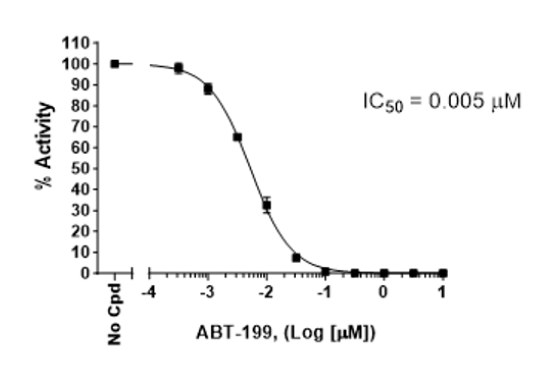BCL-2 Assay Service
●
Target
BCL-2
●
Description
Screening and/or profiling inhibitor compounds against BCL-2 ligand binding in a biochemical assay.
●
Synonyms
Bcl, Bcl2, B cell lymphoma 2, HTRF, BCLXL, BCL2
●
Example Data

*Example only, final data may vary.
Assay Details
●
Assay Format
TR-FRET
●
Reference Compounds and IC50
ABT-199, 0.005 μM
●
Assay Principle
The BCL-2 TR-FRET assay is designed to measure BCL-2 binding to its ligand in a homogenous preparation. A sample containing terbium-labeled donor, dye-labeled acceptor, BCL-2, peptide ligand, and an inhibitor is incubated for 180 minutes. The Donor Terbium-labeled anti-His antibody binds to His-tagged BCL-2. The BCL-2 peptide ligand is labeled with biotin, which allows the dye-labeled streptavidin acceptor to bind to the BCL-2 peptide ligand. The TR-FRET signal is generated by proximity induced upon interaction of BCL-2 with the BCL-2 peptide ligand. Fluorescence intensity is measured using a fluorescence reader capable of TR-FRET measurements. The signal generated is proportional to BCL-2 activity.
Target Details
●
Protein Family
Apoptosis
●
UniProt
P10415
●
Background
B-cell lymphoma 2 (BCL-2) is a member of the BCL family that regulates apoptosis through pro-apoptotic or anti-apoptotic signals. BCL-2 is normally localized at the outer membrane of mitochondria and blocks pro-apoptotic signals, promoting cell survival. Genetic alteration of BCL-2 has been observed in various types of cancer, including lymphoma, leukemia, melanoma, as well as breast and prostate cancer. The protein is also involved in cancer cell resistance to treatment due to its pro-survival functions. ABT-199, also known as Venetoclax, is a BH3-mimetic that specifically blocks the function of BCL-2 and was the first BCL-2 targeted agent to receive FDA approval (in 2016). It is now approved for the treatment of chronic lymphocytic leukemia and small lymphocytic lymphoma
Delivery
●
Estimated Turnaround
Two to three weeks following delivery of compounds
●
Results
Extensive report with raw and analyzed data, graphs, and detailed protocols. Includes positive control for inhibition.

